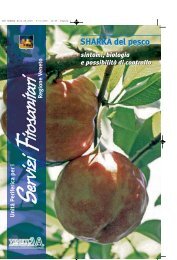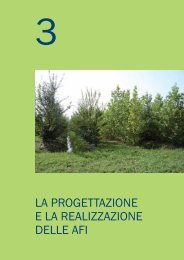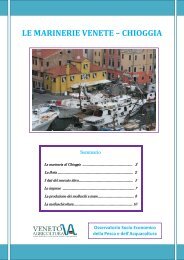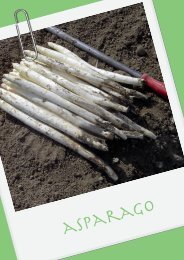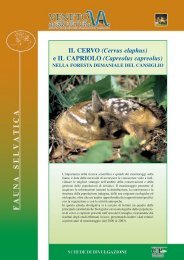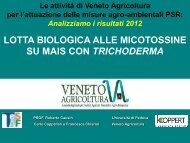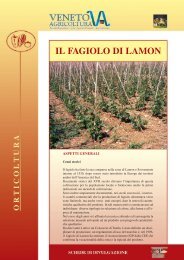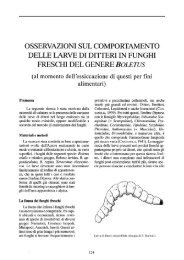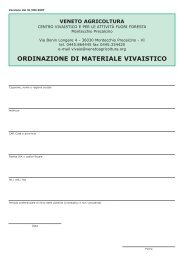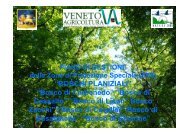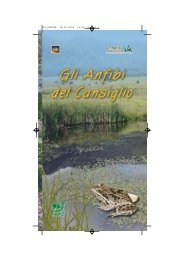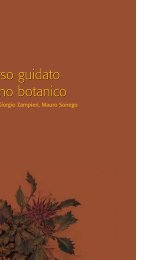produzione di cippato ottenuto dal diradamento di un arboreto per la ...
produzione di cippato ottenuto dal diradamento di un arboreto per la ...
produzione di cippato ottenuto dal diradamento di un arboreto per la ...
Create successful ePaper yourself
Turn your PDF publications into a flip-book with our unique Google optimized e-Paper software.
PRODUZIONE DI CIPPATO OTTENUTO<br />
DAL DIRADAMENTO DI UN ARBORETO<br />
PER LA PRODUZIONE DI LEGNAME<br />
DI PREGIO<br />
Nell’aprile del 2004, con l’organizzazione e il coor<strong>di</strong>namento del Centro Vivaistico e <strong>per</strong><br />
le Attività Fuori Foresta <strong>di</strong> Montecchio Precalcino (VI) <strong>di</strong> Veneto Agricoltura e <strong>la</strong> col<strong>la</strong>borazione<br />
dell’Amministrazione Provinciale <strong>di</strong> Vicenza, è stato effettuato il primo <strong>di</strong>radamento<br />
a carico <strong>di</strong> <strong>un</strong> <strong>arboreto</strong> da legno destinato al<strong>la</strong> <strong>produzione</strong> <strong>di</strong> legname <strong>di</strong> pregio.<br />
L’<strong>arboreto</strong> fu realizzato nel 1993 sui terreni dell’azienda Agrico<strong>la</strong> S<strong>per</strong>imentale del<strong>la</strong><br />
Provincia <strong>di</strong> Vicenza a Montecchio Precalcino, su progetto <strong>di</strong> Giustino Mezzalira e <strong>di</strong><br />
Enrico Buresti, ed è tuttora inserito in <strong>un</strong>a rete <strong>di</strong> impianti s<strong>per</strong>imentali dell’ISSA -<br />
Istituto S<strong>per</strong>imentale <strong>di</strong> Selvicoltura <strong>di</strong> Arezzo.<br />
Le manutenzioni e <strong>la</strong> gestione dell'impianto sono state curate negli anni <strong>dal</strong>l'ente proprietario,<br />
<strong>la</strong> Provincia <strong>di</strong> Vicenza, mentre gli interventi <strong>di</strong> potatura e <strong>la</strong> rilevazione dei<br />
dati morfometrici è stata effettuata <strong>di</strong>rettamente <strong>dal</strong>l’ISSA e da Veneto Agricoltura.<br />
Si tratta <strong>di</strong> <strong>un</strong> impianto <strong>di</strong> noce com<strong>un</strong>e (Jug<strong>la</strong>ns regia) e <strong>di</strong> ciliegio selvatico (Pr<strong>un</strong>us<br />
avium) in consociazione primaria con ontano napoletano (Alnus cordata). I moduli sul<br />
campo prevedono due tesi in consociazione secondaria, rispettivamente con nocciolo<br />
(Corylus avel<strong>la</strong>na) ed Umbel<strong>la</strong>ta (E<strong>la</strong>eagnus umbel<strong>la</strong>ta). Vi è poi <strong>un</strong>a tesi <strong>di</strong> controllo<br />
priva del<strong>la</strong> componente arbustiva.<br />
Il <strong>di</strong>radamento in questione è stato effettuato a carico del<strong>la</strong> specie consociata, con l’asportazione<br />
totale degli ontani, ormai in evidente concorrenza con le specie principali.
Per effettuare il <strong>di</strong>radamento il Centro Vivaistico e <strong>per</strong> le<br />
Attività Fuori Foresta ha fatto ricorso ad <strong>un</strong>a meccanizzazione<br />
spinta che verrà <strong>di</strong> seguito illustrata nel dettaglio.<br />
Le piante abbattute sono state <strong>di</strong>vise in due cataste <strong>di</strong>stinte,<br />
rispettivamente <strong>di</strong> 497 quintali e <strong>di</strong> 380 quintali <strong>di</strong> biomassa.<br />
Il primo gruppo <strong>di</strong> piante abbattute è stato subito <strong>cippato</strong><br />
con l’utilizzo <strong>di</strong> due grosse macchine cippatrici, l’altro è<br />
stato <strong>la</strong>sciato in campo, accumu<strong>la</strong>to in cataste, <strong>per</strong> far sì<br />
che con il tempo <strong>per</strong>desse parte dell’umi<strong>di</strong>tà contenuta<br />
nel legno. Dopo 7 mesi queste piante avevano raggi<strong>un</strong>to<br />
<strong>un</strong> contenuto <strong>di</strong> umi<strong>di</strong>tà del 30% re<strong>la</strong>tivo al peso fresco e<br />
si è proceduto al<strong>la</strong> cippatura sul secco, sempre me<strong>di</strong>ante<br />
il noleggio <strong>di</strong> <strong>un</strong>a grossa macchina cippatrice.<br />
Il <strong>cippato</strong> <strong>ottenuto</strong> sia <strong>dal</strong> primo che <strong>dal</strong> secondo gruppo<br />
<strong>di</strong> piante è stato poi utilizzato <strong>dal</strong><strong>la</strong> Com<strong>un</strong>ità Montana<br />
Leogra Timonchio come combustibile <strong>per</strong> le proprie caldaie.<br />
In questa scheda verranno <strong>di</strong> seguito illustrati:<br />
1. <strong>la</strong> composizione e <strong>la</strong> struttura dell’<strong>arboreto</strong><br />
2. le cure colturali<br />
3. le o<strong>per</strong>azioni <strong>di</strong> abbattimento meccanizzato<br />
4. le o<strong>per</strong>azioni <strong>di</strong> cippatura<br />
5. <strong>la</strong> maturazione e lo stoccaggio del <strong>cippato</strong> prodotto<br />
con il primo gruppo <strong>di</strong> piante<br />
6. le mo<strong>dal</strong>ità <strong>di</strong> ven<strong>di</strong>ta del <strong>cippato</strong> prodotto ad <strong>un</strong><br />
acquirente, in questo caso ente pubblico<br />
1. L’ ARBORETO DA LEGNO PER LA PRODUZIONE DI LEGNAME DI PREGIO<br />
Nei primi mesi del 1993, a Montecchio Precalcino, su<br />
terreno dell’Amministrazione Provinciale <strong>di</strong> Vicenza, è<br />
stato realizzata <strong>un</strong>a rete <strong>di</strong> impianti s<strong>per</strong>imentali e <strong>di</strong>mostrativi<br />
finalizzati al<strong>la</strong> in<strong>di</strong>viduazione <strong>di</strong> modelli colturali<br />
adottabili <strong>per</strong> <strong>un</strong>a arboricoltura da legno moderna,<br />
effettuata su terreni agricoli del<strong>la</strong> pianura veneta (caratteristiche<br />
dell’area s<strong>per</strong>imentale in tab. 1).<br />
Si tratta <strong>di</strong> <strong>un</strong>a consociazione tra noce com<strong>un</strong>e (Jug<strong>la</strong>ns<br />
regia), ciliegio selvatico (Pr<strong>un</strong>us avium) ed altre specie<br />
arbustive ed arboree quali ontano napoletano (Alnus cordata),<br />
umbel<strong>la</strong>ta (Eleagnus umbel<strong>la</strong>ta) e nocciolo (Corylus<br />
avel<strong>la</strong>na).<br />
7 m<br />
2<br />
1,75 m<br />
3,5 m<br />
5<br />
4 5<br />
1<br />
4<br />
4<br />
4<br />
2<br />
4<br />
4<br />
3,5 m<br />
3<br />
3<br />
3<br />
3<br />
Modulo<br />
5<br />
2 3<br />
N° Nome scientifico Nome com<strong>un</strong>e<br />
1 Jug<strong>la</strong>ns regia Nome com<strong>un</strong>e<br />
2 Pr<strong>un</strong>us avium Ciliegio selvatico<br />
3 Alnus cordata Ontano napoletano<br />
4 Corylus avel<strong>la</strong>na Nocciolo<br />
5 Eleagnus umbel<strong>la</strong>ta Umbel<strong>la</strong>ta<br />
5<br />
5<br />
5<br />
1<br />
5<br />
5<br />
3<br />
3<br />
3<br />
Turno<br />
Il turno previsto <strong>per</strong> le specie principali è <strong>di</strong> circa 30-35<br />
anni, cioè il tempo necessario <strong>per</strong> raggi<strong>un</strong>gere nel<strong>la</strong> parte<br />
alta del fusto <strong>un</strong> <strong>di</strong>ametro minimo <strong>di</strong> 30 cm.<br />
La scelta delle specie<br />
Le specie sono state scelte <strong>per</strong> <strong>la</strong> loro adattabilità alle<br />
caratteristiche climatiche e pedologiche del<strong>la</strong> stazione.<br />
La realizzazione <strong>di</strong> <strong>un</strong> impianto non può infatti mai prescindere<br />
da <strong>un</strong>’ocu<strong>la</strong>ta scelta delle specie impiegate in<br />
f<strong>un</strong>zione <strong>di</strong> queste caratteristiche, pena il non raggi<strong>un</strong>gimento<br />
degli obiettivi prefissati.<br />
Specie principale<br />
Le specie principali sono due: noce nazionale (Jug<strong>la</strong>ns<br />
regia) e ciligio selvatico (Pr<strong>un</strong>us avium).<br />
Il noce nazionale produce <strong>un</strong> legno <strong>di</strong> grande pregio che<br />
sp<strong>un</strong>ta sul mercato <strong>un</strong> prezzo <strong>di</strong> gran l<strong>un</strong>ga su<strong>per</strong>iore a<br />
quello <strong>di</strong> qualsiasi altro legno <strong>di</strong> provenienza europea.<br />
Per contro, risulta piuttosto <strong>di</strong>fficile ottenere fusti da<br />
<strong>la</strong>voro con caratteristiche ottimali, sia <strong>per</strong> motivi <strong>di</strong> conformazione<br />
del fusto, dominanza apicale e ramificazione,<br />
sia <strong>per</strong> motivi fitosanitari.<br />
Per quanto riguarda le esigenze ecologiche, il noce non<br />
tollera i ristagni idrici, i terreni argillosi compatti, ma<br />
esige terreni soffici, ben drenati, <strong>di</strong> buona fertilità, pur<br />
sopportando brevi <strong>per</strong>io<strong>di</strong> <strong>di</strong> siccità estiva. Questa specie<br />
quin<strong>di</strong> ben si adatta alle caratteristiche stazionali del<strong>la</strong><br />
zona, dove il substrato pedologico è costituito da 60-80<br />
cm <strong>di</strong> buon terreno e poi da ghiaia, con falda profonda.<br />
Il ciligio selvatico produce anch’esso <strong>un</strong> legno <strong>di</strong> ottimo<br />
pregio, anche se <strong>di</strong> valore inferiore rispetto al noce, ma è<br />
più facile da gestire <strong>per</strong> quanto riguarda <strong>la</strong> dominanza<br />
apicale, il portamento del fusto e <strong>la</strong> ramificazione. Inoltre<br />
presenta anch’esso <strong>un</strong>a buona adattabilità alle caratteristiche<br />
pedoclimatiche del<strong>la</strong> stazione.<br />
Accompagnamento primario<br />
La specie <strong>di</strong> accompagnamento ha il compito <strong>di</strong> migliorare<br />
le caratteristiche ambientali attorno al<strong>la</strong> specie principale ed<br />
è qui rappresentata <strong>dal</strong>l’ontano napoletano (Alnus cordata).
La scelta <strong>di</strong> questa specie è dovuta alle seguenti caratteristiche:<br />
- adattabilità alle caratteristiche stazionali del<strong>la</strong> zona,<br />
prima fra tutte <strong>un</strong> certo grado <strong>di</strong> siccità estiva;<br />
- capacità <strong>di</strong> questa specie <strong>di</strong> fissare l’azoto atmosferico<br />
e quin<strong>di</strong> <strong>di</strong> contribuire ad <strong>un</strong>a fertilizzazione naturale<br />
del terreno;<br />
- forma pirami<strong>dal</strong>e del<strong>la</strong> chioma che, restringendosi in<br />
alto, non va a competere con lo sviluppo delle chiome<br />
globose delle specie principali;<br />
- rapido accrescimento.<br />
Inoltre questa specie può fornire, con turni re<strong>la</strong>tivamente<br />
brevi, <strong>un</strong>a biomassa <strong>di</strong> <strong>di</strong>screta qualità <strong>per</strong> <strong>la</strong> <strong>produzione</strong><br />
<strong>di</strong> energia termica, sia sotto forma <strong>di</strong> <strong>cippato</strong>, che <strong>di</strong> legna<br />
in pezzi ed allo stesso tempo impe<strong>di</strong>sce lo sviluppo del<strong>la</strong><br />
vegetazione erbacea nell’area <strong>di</strong> insidenza del<strong>la</strong> chioma,<br />
eliminando così <strong>la</strong> necessità degli sfalci <strong>per</strong>io<strong>di</strong>ci.<br />
Specie <strong>di</strong> accompagnamento secondario<br />
Deve essere <strong>un</strong> arbusto ed il suo compito principale è<br />
quello <strong>di</strong> avvolgere con <strong>la</strong> propria chioma il fusto del<strong>la</strong><br />
specie principale. Ciò <strong>per</strong> impe<strong>di</strong>re il riscoppio dei rami<br />
<strong>la</strong>terali dopo <strong>la</strong> potatura <strong>di</strong> formazione che causerebbero<br />
<strong>la</strong> formazione del cosiddetto “nodo su nodo”, <strong>un</strong> <strong>di</strong>fetto<br />
del legno tra i più penalizzanti <strong>la</strong> qualità. L’arbusto ha poi<br />
<strong>un</strong>o sviluppo in altezza che non su<strong>per</strong>a i 4-5 metri <strong>per</strong> cui<br />
non va ad interferire con lo sviluppo del<strong>la</strong> chioma delle<br />
specie arboree.<br />
Inoltre esso va ad occupare le chiarie rimaste libere <strong>dal</strong>l’area<br />
<strong>di</strong> insidenza delle chiome delle altre specie, eliminando<br />
così completamente <strong>la</strong> necessità <strong>di</strong> sfalcio a partire<br />
già dai primi 3-4 anni <strong>dal</strong>l’impianto.<br />
Nel nostro caso le specie impiegate sono: il nocciolo e<br />
l’umbel<strong>la</strong>ta. Entrambe le specie si adattano bene alle<br />
caratteristiche stazionali e ri<strong>la</strong>sciano <strong>un</strong>a buona lettiera;<br />
l’umbel<strong>la</strong>ta in più ha <strong>la</strong> capacità <strong>di</strong> fissare l’azoto atmosferico,<br />
<strong>per</strong> cui contribuisce con l’ontano a fertilizzare il<br />
terreno. Entrambe le specie risultano utili all’apicoltura<br />
<strong>per</strong> <strong>la</strong> <strong>produzione</strong> <strong>di</strong> polline (nocciolo) e nettare (umbel<strong>la</strong>ta)<br />
ed a fine turno potrebbero essere cippate e sfruttate<br />
quin<strong>di</strong> come biomassa a fini energetici.<br />
La consociazione offre 2 importanti vantaggi:<br />
- l’impianto è biologicamente più stabile in quanto <strong>la</strong><br />
mesco<strong>la</strong>nza <strong>di</strong> specie rende molto più <strong>di</strong>fficoltosa <strong>la</strong><br />
<strong>di</strong>ffusione dei patogeni all’interno dell’<strong>arboreto</strong>;<br />
- l’impianto è fisicamente più stabile in quanto le piante<br />
si proteggono le <strong>un</strong>e con le altre contro gli eventi<br />
atmosferici, quali vento, gran<strong>di</strong>ne, ecc. In partico<strong>la</strong>re il<br />
noce, partico<strong>la</strong>rmente fragile nei primi 5-8 anni e soprattutto<br />
nel <strong>per</strong>iodo tardo primaverile - inizio estate,<br />
viene protetto <strong>dal</strong>le chiome degli ontani.<br />
La messa a <strong>di</strong>mora delle piantine<br />
La preparazione del terreno venne effettuata prima con<br />
<strong>un</strong>a rip<strong>un</strong>tatura, eseguita nel novembre ’92, ad <strong>un</strong>a profon<strong>di</strong>tà<br />
<strong>di</strong> <strong>di</strong> circa 70 cm; <strong>un</strong>a seconda rip<strong>un</strong>tatura è stata<br />
effettuata nel febbraio 1993 eseguita con passaggi incrociati<br />
al<strong>la</strong> stessa profon<strong>di</strong>tà. Subito dopo, senza eseguire<br />
ness<strong>un</strong>a concimazione organica o minerale, è stata effettuata<br />
<strong>un</strong>’aratura su<strong>per</strong>ficiale (30-35 cm), <strong>un</strong>’estirpatura<br />
ed al<strong>la</strong> fine si è rifinito il terreno con <strong>un</strong>a fresatura.<br />
Le piantine sono state messe a <strong>di</strong>mora previa stesura del<br />
telo pacciamante stabilizzato ai raggi ultravioletti con<br />
Etil-Vinil-Acetato (EVA).<br />
F<strong>un</strong>zioni<br />
La f<strong>un</strong>zione principale è qui rivolta al<strong>la</strong> <strong>produzione</strong> <strong>di</strong><br />
legname <strong>di</strong> pregio <strong>per</strong> l’industria del mobile, dei serramenti<br />
e dell’arredo in generale.<br />
Contemporaneamente l’<strong>arboreto</strong> svolge altre f<strong>un</strong>zioni <strong>di</strong><br />
primaria importanza, che verranno descritte in seguito;<br />
ma tutte le o<strong>per</strong>azioni effettuate, <strong>dal</strong><strong>la</strong> progettazione e<br />
realizzazione dell’impianto, fino a tutte le cure colturali,<br />
hanno come obiettivo primario l’ottimizzazione del<strong>la</strong><br />
f<strong>un</strong>zione principale.<br />
Le altre f<strong>un</strong>zioni sono:<br />
- f<strong>un</strong>zione s<strong>per</strong>imentale<br />
- f<strong>un</strong>zione <strong>di</strong>mostrativa<br />
- <strong>produzione</strong> biomassa a fini energetici<br />
- miglioramento del paesaggio<br />
- formazione <strong>di</strong> <strong>un</strong> habitat in grado <strong>di</strong> ospitare <strong>la</strong> fa<strong>un</strong>a<br />
selvatica<br />
- f<strong>un</strong>zione mellifera<br />
- f<strong>un</strong>zione ambientale<br />
Prodotto principale: legname <strong>di</strong> pregio<br />
Il legname che questo tipo <strong>di</strong> <strong>arboreto</strong> è chiamato a produrre<br />
sarà destinato al<strong>la</strong> fabbricazione <strong>di</strong> mobili, arredo<br />
in generale, serramenti ed altri prodotti <strong>di</strong> falegnameria<br />
fine e proprio <strong>per</strong> questo motivo esso dovrà possedere<br />
delle caratteristiche tecnologiche ben precise.<br />
In partico<strong>la</strong>re i fusti da <strong>la</strong>voro che si ottengono da questo<br />
tipo <strong>di</strong> arboreti possono seguire due vie:<br />
- tranceria: dove il fusto viene trasformato in fogli dello<br />
spessore <strong>di</strong> qualche decimo <strong>di</strong> mm;<br />
- segheria: dove il fusto viene trasformato in tavole <strong>di</strong><br />
vario spessore e l<strong>un</strong>ghezza.<br />
Tranceria<br />
Al<strong>la</strong> trancia possono essere destinati solo i fusti migliori,<br />
cioè quelli dritti, a sezione cilindrica, con anelli rego<strong>la</strong>ri<br />
e concentrici, completamente privi <strong>di</strong> no<strong>di</strong> ed altri <strong>di</strong>fetti<br />
del legno dovuti a ma<strong>la</strong>ttie, attacchi <strong>di</strong> insetti o traumi <strong>di</strong><br />
vario genere.<br />
Inoltre ci sono delle misure minime che devono essere<br />
sod<strong>di</strong>sfatte: il tronco da trancia deve avere <strong>un</strong>a l<strong>un</strong>ghezza<br />
minima <strong>di</strong> 2,50 metri ed <strong>un</strong> <strong>di</strong>ametro nel<strong>la</strong> sua sezione<br />
inferiore <strong>di</strong> almeno 30 centimetri.<br />
Segheria<br />
Le caratteristiche dei tronchi da sega possono essere <strong>un</strong><br />
po’ meno rigorose, anche <strong>per</strong>chè il tavo<strong>la</strong>me che se ne<br />
ricava viene c<strong>la</strong>ssificato in c<strong>la</strong>ssi <strong>di</strong> qualità, <strong>per</strong> cui anche<br />
<strong>la</strong> presenza <strong>di</strong> qualche <strong>di</strong>fetto non esclude <strong>la</strong> possibilità <strong>di</strong><br />
<strong>un</strong> eventuale utilizzo.<br />
3
In pratica le caratteristiche a cui si tende sono le stesse<br />
del legno da trancia, ma anche se il tronco presenta qualche<br />
nodo o qualche altra im<strong>per</strong>fezione può avere lo stesso<br />
vari impieghi in falegnameria.<br />
L’<strong>arboreto</strong> in questione è strutturato proprio <strong>per</strong> facilitare<br />
il più possibile l’ottenimento del prodotto come sopra<br />
descritto.<br />
Produzione accessoria: biomassa legnosa a scopo<br />
energetico<br />
Come già specificato in precedenza, l’ontano napoletano<br />
va eliminato ad <strong>un</strong> certo p<strong>un</strong>to del ciclo dell’<strong>arboreto</strong>, <strong>per</strong><br />
Le cure colturali all’<strong>arboreto</strong> consistono in:<br />
- trinciatura dell’erba negli interfi<strong>la</strong>ri nei primi 3-5 anni,<br />
fintanto cioè che le chiome non si sono chiuse impedendovi<br />
lo sviluppo dell’erba;<br />
- <strong>di</strong>serbo chimico o manuale nel foro d’impianto in corrispondenza<br />
delle giovani piantine, da eseguirsi solo<br />
nei primi 2-3 anni;<br />
- potature <strong>di</strong> formazione a carico delle specie destinate a<br />
produrre fusto da <strong>la</strong>voro, in questo caso noce e ciliegio;<br />
tali potature devono iniziare al 2°-3° anno e protrarsi<br />
fino al 7°-8° anno o com<strong>un</strong>que fintanto che non si sono<br />
ottenuti fusti liberi da rami fino ad <strong>un</strong>’altezza <strong>di</strong> almeno<br />
3 m <strong>dal</strong> suolo;<br />
Nell’aut<strong>un</strong>no del 2003 gli Ontani napoletani avevano<br />
raggi<strong>un</strong>to <strong>di</strong>mensioni del<strong>la</strong> chioma tali da ostaco<strong>la</strong>re <strong>un</strong><br />
rego<strong>la</strong>re sviluppo delle due specie principali, cioè del<br />
noce e del ciliegio.<br />
Era quin<strong>di</strong> gi<strong>un</strong>to il momento <strong>di</strong> abbatterli, quin<strong>di</strong> il <strong>di</strong>radamento<br />
prevedeva <strong>la</strong> rimozione integrale delle file <strong>di</strong><br />
ontano, che doveva essere effettuata con estrema attenzione,<br />
<strong>per</strong> evitare danni al soprassuolo residuo.<br />
Il <strong>la</strong>voro è stato effettuato secondo tre tesi <strong>di</strong>stinte, <strong>di</strong> cui<br />
si è verificata <strong>la</strong> produttività, il costo <strong>un</strong>itario <strong>di</strong> raccolta<br />
e <strong>la</strong> compatibilità con gli obiettivi qualitativi dell’intervento,<br />
cioè il rispetto assoluto delle piante ri<strong>la</strong>sciate e del<br />
suolo <strong>per</strong>corso. Tutte le tesi prevedevano l’esbosco del<strong>la</strong><br />
pianta intera, con cippatura all’imposto – in questo caso<br />
<strong>un</strong> campo libero imme<strong>di</strong>atamente a<strong>di</strong>acente al<strong>la</strong> piantagione.<br />
Le tre tesi si <strong>di</strong>fferenziavano essenzialmente <strong>per</strong> il<br />
tipo <strong>di</strong> meccanizzazione impiegata: bassa, alta e polivalente,<br />
alta e specifica.<br />
La tesi a meccanizzazione bassa consisteva in <strong>un</strong> cantiere<br />
c<strong>la</strong>ssico, basato sul<strong>la</strong> motosega e sul trattore agricolo.<br />
Le piante erano abbattute da <strong>un</strong>a squadra <strong>di</strong> due o<strong>per</strong>ai<br />
m<strong>un</strong>iti <strong>di</strong> motosega, <strong>di</strong> cui <strong>un</strong>o effettuava il taglio e l’al-<br />
4<br />
2. LE CURE COLTURALI<br />
3. LE OPERAZIONI DI ABBATTIMENTO<br />
evitare che ostacoli lo sviluppo delle specie principali. In<br />
questa occasione si può ottenere <strong>dal</strong> <strong>di</strong>radamento <strong>un</strong>a<br />
cospiqua quantità <strong>di</strong> biomassa legnosa a scopo energetico.<br />
L’ontano produce <strong>un</strong> legno non molto denso che<br />
come legna in pezzi <strong>per</strong> stufe o caldaie è migliore <strong>di</strong> salice<br />
o pioppo, ma assai più scadente <strong>di</strong> specie a legno duro<br />
quali faggio o carpino. Si ottiene invece <strong>un</strong> <strong>cippato</strong> <strong>di</strong><br />
ottima qualità <strong>per</strong> l’utilizzo nelle caldaie che f<strong>un</strong>zionano<br />
con questo tipo <strong>di</strong> prodotto. La spesa <strong>per</strong> effettuare le<br />
o<strong>per</strong>azioni <strong>di</strong> <strong>di</strong>radamento può così trasformarsi in <strong>un</strong><br />
piccolo guadagno come verrà specificato nei paragrafi<br />
seguenti.<br />
- <strong>di</strong>radamento a carico del<strong>la</strong> specie secondaria, cioè<br />
l’Ontano napoletano; <strong>la</strong> scelta del momento in cui <strong>di</strong>radare<br />
è assai delicata in quanto, se eseguita troppo presto<br />
<strong>la</strong>scia esposte agli agenti atmosferici avversi le<br />
piante <strong>di</strong> noce ancora troppo fragili; se eseguita troppo<br />
tar<strong>di</strong>vamente, cioè quando le chiome delle due <strong>di</strong>verse<br />
specie già da tempo si toccano e si fanno concorrenza,<br />
a carico delle specie principali si forma <strong>un</strong>a riduzione<br />
dello spessore degli anelli del legno e, successivamente<br />
al <strong>di</strong>radamento, <strong>un</strong> aumento <strong>di</strong> tale spessore; il legno<br />
che ne risulta a maturità non sarà omogeneo come<br />
invece richiesto <strong>dal</strong>l’industria, e quin<strong>di</strong> risulterà <strong>di</strong><br />
minore qualità e valore economico.<br />
tro <strong>di</strong>rigeva <strong>la</strong> caduta del<strong>la</strong> pianta verso il centro del<strong>la</strong> fi<strong>la</strong><br />
<strong>per</strong> evitare danni alle piante <strong>di</strong> noce e ciliegio.<br />
Concentramento ed esbosco erano effettuati da <strong>un</strong> solo<br />
o<strong>per</strong>aio, che impiegava <strong>un</strong> trattore agricolo m<strong>un</strong>ito <strong>di</strong><br />
verricello a due tamburi (fig.1). Questa tesi esemplifica il<br />
caso del<strong>la</strong> gestione <strong>di</strong>retta da parte dell’agricoltore, con<br />
conseguente limitazione nel<strong>la</strong> capacità <strong>di</strong> investimento in<br />
attrezzature meccaniche specializzate.<br />
Fig. 1
Fig. 2<br />
La tesi a meccanizzazione alta e polivalente era im<strong>per</strong>niata<br />
su <strong>un</strong> escavatore leggero m<strong>un</strong>ito <strong>di</strong> testa <strong>di</strong> abbattimento<br />
con sega a catena (fig. 2), capace <strong>di</strong> tagliare <strong>un</strong><br />
<strong>di</strong>ametro massimo <strong>di</strong> 60 cm. Macchine <strong>di</strong> questo tipo<br />
sono abbastanza <strong>di</strong>ffuse in pioppicoltura (Cielo et. al.,<br />
2001) e possono essere impiegate <strong>per</strong> effettuare <strong>un</strong>a<br />
varietà <strong>di</strong> <strong>la</strong>vorazioni boschive, quali l’abbattimento, il<br />
concentramento e il carico - data l’inerente polivalenza<br />
dell’escavatore idraulico (Johansson, 2001). L’abbattitrice<br />
tagliava le piante e le concentrava in fastelli <strong>di</strong> 5-8<br />
pezzi, così da facilitarne l’esbosco.<br />
Il preventivo concentramento effettuato <strong>dal</strong>l’abbattitrice<br />
consentiva infatti <strong>di</strong> impiegare <strong>un</strong> trattore agricolo m<strong>un</strong>ito<br />
<strong>di</strong> pinza posteriore da strascico (figg. 3-4), estremamente<br />
più rapido del trattore con verricello.<br />
Fig. 3<br />
Fig. 4<br />
Oltretutto, il <strong>la</strong>voro con <strong>la</strong> pinza da strascico era molto<br />
più leggero <strong>per</strong> il trattorista, che non doveva scendere <strong>dal</strong><br />
trattore <strong>per</strong> agganciare il carico. Anche in questo caso il<br />
<strong>la</strong>voro era eseguito da <strong>un</strong> solo o<strong>per</strong>aio.<br />
La tesi a meccanizzazione alta e specifica impiegava<br />
<strong>un</strong>’abbattitrice-affastel<strong>la</strong>trice a <strong>di</strong>sco, applicata ad <strong>un</strong><br />
minicaricatore tipo Bobcat con cingo<strong>la</strong>tura in gomma<br />
(fig. 5). L’abbattitrice aveva <strong>un</strong>a capacità <strong>di</strong> taglio pari a<br />
35 cm e due bracci <strong>di</strong> presa in<strong>di</strong>pendenti che gli consentivano<br />
<strong>di</strong> afferrare più piante <strong>per</strong> ciasc<strong>un</strong> ciclo <strong>di</strong> <strong>la</strong>voro.<br />
Il peso totale dell’attrezzo sfiorava i 700 kg, contro i<br />
quasi 3000 delle grosse abbattitrici a <strong>di</strong>sco <strong>di</strong> tipo standard,<br />
che richiedono <strong>un</strong>a motrice molto più pesante. La<br />
macchina impiegata nel<strong>la</strong> prova invece poteva essere<br />
applicata all’attacco <strong>un</strong>iversale <strong>di</strong> qualsiasi minicaricatore<br />
capace <strong>di</strong> erogare sufficiente potenza idraulica. In<br />
linea generale <strong>un</strong>a motrice <strong>di</strong> questo tipo pesa al massimo<br />
quattro tonnel<strong>la</strong>te ed il suo accoppiamento con l’abbattitrice<br />
a <strong>di</strong>sco genera <strong>un</strong> mezzo agile, leggero ed economico.<br />
L’<strong>un</strong>ico limite è <strong>la</strong> re<strong>la</strong>tiva specializzazione del<strong>la</strong><br />
macchina, dato che, in configurazione “abbattitrice”, il<br />
minicaricatore può solo effettuare abbattimento e concentramento,<br />
e si presta male ai <strong>la</strong>vori <strong>di</strong> carico, accatastamento<br />
e sezionatura. Oltretutto <strong>la</strong> capacità <strong>di</strong> taglio<br />
limitata e <strong>la</strong> necessità <strong>di</strong> raggi<strong>un</strong>gere <strong>di</strong>rettamente il<br />
piede <strong>di</strong> ciasc<strong>un</strong>a pianta da tagliare ne limita l’impiego<br />
alle giovani piantagioni poste in terreno agevole, come<br />
app<strong>un</strong>to quelle finalizzate al<strong>la</strong> <strong>produzione</strong> <strong>di</strong> legname <strong>di</strong><br />
qualità o <strong>di</strong> biomassa. D’altra parte, il minicaricatore può<br />
essere equipaggiato alternativamente con <strong>un</strong>a varietà <strong>di</strong><br />
attrezzature, quali pinze da carico, decespugliatori o<br />
5
enne, che ne consentono <strong>un</strong> impiego abbastanza <strong>di</strong>versificato.<br />
L’attacco <strong>un</strong>iversale poi agevo<strong>la</strong> <strong>la</strong> sostituzione<br />
dell’attrezzo, che in genere richiede meno <strong>di</strong> 15 minuti.<br />
Uno degli Autori aveva già <strong>la</strong>vorato con questo tipo <strong>di</strong><br />
macchina negli Stati Uniti, convincendosi che <strong>la</strong> tecnologia<br />
potesse essere trasferita con profitto al<strong>la</strong> realtà<br />
Italiana (Spinelli, 2003): con <strong>la</strong> col<strong>la</strong>borazione del costruttore<br />
Canadese e dell’importatore Italiano, <strong>la</strong> macchina<br />
è stata portata in Italia e utilizzata <strong>per</strong> <strong>la</strong> prima volta<br />
in occasione del<strong>la</strong> prova <strong>di</strong> Montecchio. Anche in questo<br />
caso, l’abbattitrice formava fastelli <strong>di</strong> 5-8 piante, che<br />
erano esboscati con <strong>un</strong> trattore agricolo m<strong>un</strong>ito <strong>di</strong> pinza<br />
posteriore da strascico.<br />
4. LE OPERAZIONI DI CIPPATURA<br />
La cippatura è stata effettuata all’imposto con due macchine<br />
<strong>di</strong>verse: <strong>un</strong>a cippatrice carrel<strong>la</strong>ta azionata da <strong>un</strong><br />
trattore agricolo da 215 hp ed <strong>un</strong>a cippatrice autocarrata<br />
con motore autonomo da 450 hp (fig. 6). Entrambe le<br />
cippatrici erano del tipo a tamburo, avevano <strong>un</strong>a bocca <strong>di</strong><br />
alimentazione <strong>la</strong>terale con tavo<strong>la</strong> <strong>di</strong> appoggio e convogliatore,<br />
ed erano m<strong>un</strong>ite <strong>di</strong> <strong>un</strong>a gru idraulica incorporata<br />
<strong>per</strong> <strong>la</strong> movimentazione del legname. Le due macchine<br />
erano destinate a simu<strong>la</strong>re due <strong>di</strong>versi livelli impren<strong>di</strong>toriali:<br />
<strong>la</strong> coo<strong>per</strong>ativa <strong>di</strong> produttori o il piccolo contoterzista<br />
dotati <strong>di</strong> <strong>un</strong>a capacità <strong>di</strong> investimento me<strong>di</strong>o-bassa e<br />
il contoterzista specializzato pronto ad investire cifre più<br />
elevate pur <strong>di</strong> mettere in campo il massimo del<strong>la</strong> tecnologia<br />
<strong>di</strong>sponibile. Il <strong>cippato</strong> veniva scaricato <strong>di</strong>rettamente<br />
in rimorchi agricoli e portato in azienda <strong>per</strong> <strong>la</strong> successiva<br />
pesatura, scarico e stoccaggio.<br />
Le caratteristiche <strong>di</strong> tutte le macchine impiegate sono<br />
riportate nel<strong>la</strong> tabel<strong>la</strong> qui <strong>di</strong> seguito illustrata.<br />
6<br />
Macchina Motosega Abbattitrice Abbattitrice Trattore Trattore Cippatrice Cippatrice<br />
Motrice - Escavatore Caricatore Trattore Trattore Trattore Autocarro<br />
Marca Husqvarna Fiat-Hitachi Bobcat Fiat Fiat John Deere Scania<br />
Modello 55 FH 120.2 T 300 F100 F100 8320 R 113H<br />
Potenza (kW) 2.5 63 58 74 74 152 280<br />
Peso (kg) 6.2 12000 4300 8100 8100 10200 8100<br />
Tras<strong>la</strong>zione - Cingoli Cingoli Pneumatici Pneumatici Pneumatici Pneumatici<br />
O<strong>per</strong>atrice - Testa Testa Verricello Pinza Cippatrice Cippatrice<br />
Marca - Hult<strong>di</strong>ns Davco Farmi Fransgård Muss-Max Jenz<br />
Modello - SF 560 QC 1400 JL 600/2 HZ 2300 T 6 560D<br />
Potenza (kW) - 74 - - - - 335<br />
Peso (kg) - 625 680 650 330 2900 8200<br />
O<strong>per</strong>atori 2 1 1 1 1 1 1<br />
Investimento (Euro) 700 100000 75000 55000 55000 140000 240000<br />
Euro/ora lorda 32 53 43 36 36 68 115<br />
Fig. 5
Fig. 6<br />
Quantitativi <strong>di</strong> <strong>cippato</strong> al momento del<strong>la</strong> raccolta<br />
Modello m Quintali UM % riferita Quintali<br />
cippatrice steri tal quale al peso fresco sost secca<br />
Muss-Max 54,7 174,3 47,8 91,0<br />
Jenz 80,0 322,7 47,8 168,4<br />
Totale 134,7 497,0 259,4<br />
CONSIDERAZIONI RELATIVE AI CANTIERI DI<br />
ABBATTIMENTO E CIPPATURA<br />
Il rilievo dei tempi <strong>di</strong> <strong>la</strong>voro e delle masse prodotte ha<br />
consentito <strong>di</strong> quantificare <strong>la</strong> produttività dei cantieri,<br />
separatamente <strong>per</strong> ciasc<strong>un</strong>a fase. I dati sono stati sottoposti<br />
ad analisi statistica <strong>per</strong> evidenziare eventuali corre<strong>la</strong>zioni<br />
tra il tempo <strong>di</strong> <strong>la</strong>vorazione e le con<strong>di</strong>zioni <strong>di</strong> <strong>la</strong>voro:<br />
in tal modo è stato possibile ottenere delle equazioni<br />
capaci <strong>di</strong> calco<strong>la</strong>re <strong>la</strong> produttività <strong>di</strong> ciasc<strong>un</strong>a attrezzatura<br />
in f<strong>un</strong>zione dello sviluppo del popo<strong>la</strong>mento. I risultati<br />
<strong>di</strong> questi calcoli sono riportati nel grafico 2 <strong>per</strong> l’abbattimento<br />
e nel grafico 3 <strong>per</strong> l’esbosco. Le figure riportano<br />
<strong>un</strong>a produttività lorda, ottenuta aggi<strong>un</strong>gendo <strong>un</strong>a quota<br />
fissa <strong>di</strong> tempi morti al tempo netto <strong>ottenuto</strong> con le equazioni<br />
appena citate. Tale quota è stata considerata pari al<br />
25% <strong>per</strong> le attrezzature meccaniche e al 40% <strong>per</strong> <strong>la</strong> motosega,<br />
in considerazione del<strong>la</strong> maggior fatica sofferta<br />
dagli o<strong>per</strong>atori.<br />
L’abbattimento meccanizzato è più produttivo rispetto a<br />
quello manuale e consente <strong>di</strong> triplicare <strong>la</strong> produttività<br />
del<strong>la</strong> manodo<strong>per</strong>a. Il minicaricatore su<strong>per</strong>a l’escavatore<br />
sui <strong>di</strong>ametri compresi tra 10 e 20 cm, confermandosi<br />
come l’attrezzatura ideale <strong>per</strong> questo tipo <strong>di</strong> interventi.<br />
L’escavatore invece è più efficace con i <strong>di</strong>ametri maggiori<br />
<strong>di</strong> 20 cm, come ci si può aspettare da <strong>un</strong>a macchina<br />
progettata <strong>per</strong> l’impiego nei tagli <strong>di</strong> maturità.<br />
In<strong>di</strong>pendentemente <strong>dal</strong> tipo <strong>di</strong> macchina, l’abbattimento<br />
meccanizzato è molto più comodo e sicuro <strong>di</strong> quello<br />
manuale. Oltretutto, <strong>la</strong> macchina non si limita ad abbattere<br />
le piante, ma le concentra in fastelli, consentendo<br />
<strong>un</strong>a mo<strong>dal</strong>ità <strong>di</strong> esbosco molto più efficace rispetto a<br />
qul<strong>la</strong> attuabile dopo l’abbattimento manuale. Il trattore<br />
con pinza infatti deve solo esboscare i fastelli formati<br />
<strong>dal</strong><strong>la</strong> macchina e riesce a mantenere <strong>un</strong> ritmo <strong>di</strong> <strong>la</strong>voro<br />
molto più veloce rispetto al trattore con verricello, che<br />
deve anche effettuare il concentramento, <strong>un</strong> <strong>la</strong>voro lento<br />
e faticoso. La produttività del trattore con pinza è più che<br />
doppia rispetto a quel<strong>la</strong> del trattore con verricello solo se<br />
le piante sono molto sviluppate ed è possibile formare <strong>un</strong><br />
carico adeguato ri<strong>un</strong>endo pochi pezzi.<br />
La produttività delle due cippatrici testate è adeguata al<br />
tipo <strong>di</strong> macchina: 80 q/ora <strong>per</strong> <strong>la</strong> versione applicata al<br />
trattore e 290 q/ora <strong>per</strong> quel<strong>la</strong> pesante autocarrata. Questi<br />
valori si riferiscono all’ora lorda, comprensiva del 25%<br />
<strong>di</strong> tempi morti. La cippatrice autocarrata ha <strong>un</strong> costo orario<br />
quasi doppio rispetto a quel<strong>la</strong> applicata al trattore, ma<br />
produce più <strong>di</strong> tre volte tanto ed è molto più mobile; essa<br />
è adatta al contoterzista specializzato, capace <strong>di</strong> spostarsi<br />
velocemente e mobilizzare lotti <strong>di</strong>s<strong>per</strong>si in tempi ridotti.<br />
Il <strong>di</strong>scorso è interessante soprattutto se si pensa <strong>di</strong><br />
stoccare le piante agli imposti <strong>per</strong> favorirne <strong>la</strong> stagionatura,<br />
trasformandole in <strong>cippato</strong> solo prima dell’uso. In tal<br />
caso, <strong>la</strong> cippatura avverrebbe durante <strong>la</strong> stagione invernale,<br />
secondo <strong>la</strong> logica del “just in time”, che prevede<br />
consegne tempestive e il minimo accumulo <strong>di</strong> combustibile<br />
in centrale.<br />
In ogni caso, il ricorso al<strong>la</strong> cippatura integrale e l’impiego<br />
<strong>di</strong> attrezzature adeguate <strong>per</strong>mettono <strong>di</strong> abbattere i<br />
costi <strong>di</strong> raccolta in modo considerevole. Nelle con<strong>di</strong>zioni<br />
<strong>di</strong> <strong>la</strong>voro del popo<strong>la</strong>mento in oggetto e secondo le ipotesi<br />
economiche illustrate in precedenza, il costo del <strong>cippato</strong><br />
a bocca del<strong>la</strong> cippatrice varia dai 3.2 Euro/q <strong>per</strong> <strong>la</strong><br />
tesi a bassa meccanizzazione a 1.6 Euro/q <strong>per</strong> quel<strong>la</strong><br />
più meccanizzata. Nel grafico 4 è riportato l’andamento<br />
dei costi <strong>di</strong> raccolta in f<strong>un</strong>zione dello sviluppo delle piante<br />
utilizzate <strong>per</strong> le <strong>di</strong>verse tesi oggetto <strong>di</strong> stu<strong>di</strong>o. In me<strong>di</strong>a,<br />
<strong>la</strong> meccanizzazione consente <strong>un</strong>a riduzione dei costi <strong>di</strong><br />
raccolta del 40%. Cosa altrettanto importante, essa offre<br />
7
con<strong>di</strong>zioni <strong>di</strong> <strong>la</strong>voro più comode e sicure, e riesce a compensare<br />
<strong>la</strong> crescente carenza <strong>di</strong> manodo<strong>per</strong>a ormai evidente<br />
anche in agricoltura.<br />
Impiegando i valori riportati nel grafico 4 ed ipotizzando<br />
<strong>un</strong> prezzo del <strong>cippato</strong> <strong>di</strong> 3,5 Euro/q a bocca del<strong>la</strong> cippatrice,<br />
è stato possibile calco<strong>la</strong>re <strong>la</strong> red<strong>di</strong>tività dell’intervento.<br />
Questo risulta rem<strong>un</strong>erativo a partire da <strong>un</strong> <strong>di</strong>ametro<br />
minimo delle piante prelevate <strong>di</strong> 14 cm a petto d’uomo<br />
<strong>per</strong> <strong>la</strong> tesi a bassa meccanizzazione, e <strong>di</strong> 10 cm <strong>per</strong> le<br />
altre due tesi. Il <strong>di</strong>radamento meccanizzato dei popo<strong>la</strong>menti<br />
più sviluppati può fornire <strong>un</strong> red<strong>di</strong>to interessante<br />
all’agricoltore - <strong>un</strong> risultato ancora più positivo se si considera<br />
che finora <strong>la</strong> prospettiva era quel<strong>la</strong> <strong>di</strong> <strong>un</strong> intervento<br />
colturale da effettuarsi a titolo oneroso.<br />
Oltretutto, i rilievi effettuati <strong>di</strong>mostrano che <strong>la</strong> meccanizzazione<br />
del <strong>di</strong>radamento non comporta alc<strong>un</strong>a riduzione<br />
del suo valore colturale: l’entità dei danni al soprassuolo<br />
residuo e il compattamento del terreno sono minimi <strong>per</strong><br />
tutte le tesi e non <strong>di</strong>fferiscono in modo significativo con<br />
il tipo <strong>di</strong> trattamento.<br />
Tabel<strong>la</strong> 1 - Caratteristiche dell’area s<strong>per</strong>imentale<br />
Tabel<strong>la</strong> 2 - Red<strong>di</strong>tività del <strong>di</strong>radamento <strong>per</strong> le <strong>di</strong>verse opzioni<br />
8<br />
Com<strong>un</strong>e Montecchio Precalcino<br />
Su<strong>per</strong>ficie Ha 1.73<br />
Specie principale Jug<strong>la</strong>ns regia, Pr<strong>un</strong>us avium<br />
Specie accessoria Alnus cordata<br />
Età anni 10<br />
Intervento Rimozione specie accessoria<br />
Criterio Geometrico<br />
File rimosse Numero 18<br />
Prelievo piante/ha 529<br />
Prelievo q/ha 506<br />
Pianta me<strong>di</strong>a prelevata kg 96<br />
Ø 1,30 prelievo cm 14.8<br />
Pendenza me<strong>di</strong>a % 0<br />
Accidentalità C<strong>la</strong>sse 1<br />
Tenore idrico del legno % 47.8<br />
Densità del legno kg/m 3 972<br />
Il cantiere più efficace è costituito da <strong>un</strong>’abbattitrice, <strong>un</strong><br />
trattore con pinza da esbosco e <strong>un</strong>a cippatrice. La recentissima<br />
introduzione in Italia <strong>di</strong> teste abbattitrici <strong>per</strong> l’applicazione<br />
sui minicaricatori apre nuove possibilità, svinco<strong>la</strong>ndo<br />
<strong>la</strong> meccanizzazione dell’abbattimento <strong>dal</strong>l’impiego<br />
<strong>di</strong> macchine grosse e ingombranti. Il minicaricatore<br />
non ha <strong>la</strong> stessa flessibilità o<strong>per</strong>ativa delle abbattitrici<br />
dotate <strong>di</strong> <strong>un</strong> braccio idraulico, ma è molto più agile ed<br />
economico: il suo limite principale è dato <strong>dal</strong><strong>la</strong> <strong>di</strong>fficoltà<br />
a transitare su terreni pendenti o accidentati, ma questo<br />
non è assolutamente il caso delle piantagioni <strong>di</strong> arboricoltura<br />
da legno.<br />
La meccanizzazione integrale del<strong>la</strong> raccolta offre <strong>un</strong><br />
risultato economico interessante e può rendere rem<strong>un</strong>erativo<br />
anche il <strong>di</strong>radamento. Il costo <strong>di</strong> raccolta può essere<br />
abbassato sotto i 2 Euro/q e l’intervento può generare<br />
oltre 1000 Euro/ha al netto delle spese - sempre<br />
secondo le ipotesi economiche adottate dagli Autori.<br />
Red<strong>di</strong>to Euro/ha<br />
D 1.30 Cippatrice su trattore Cippatrice pesante autocarrata<br />
cm Motosega Escavatore Bobcat Motosega Escavatore Bobcat<br />
9 -232 -46 26 -161 26 97<br />
10 -197 44 117 -106 135 208<br />
11 -155 148 222 -40 262 336<br />
12 -103 267 343 37 407 483<br />
13 -43 402 480 127 572 650<br />
14 26 556 635 230 759 839<br />
15 105 728 810 347 969 1051<br />
16 195 920 1005 478 1203 1287<br />
17 296 1133 1221 624 1461 1549<br />
18 435 1368 1459 813 1746 1837<br />
19 741 1611 1719 1174 2045 2153<br />
20 1070 1911 2004 1563 2404 2497<br />
21 1429 2236 2312 1986 2794 2870<br />
22 1818 2589 2645 2446 3217 3273
5. LA MATURAZIONE E LO STOCCAGGIO DEL CIPPATO PRODOTTO<br />
I 497 quintali <strong>di</strong> <strong>cippato</strong> subito prodotto sono stati stoccati<br />
presso il piazzale asfaltato del Centro Vivaistico e <strong>per</strong><br />
le Attività Fuori Foresta <strong>di</strong> Montecchio Precalcino. Qui,<br />
ri<strong>un</strong>ito in <strong>un</strong> cumulo <strong>la</strong>rgo 4 m, alto 1,5 m e l<strong>un</strong>go 25 m,<br />
il <strong>cippato</strong> è stato subito co<strong>per</strong>to con <strong>un</strong> telo costituito da<br />
<strong>un</strong> partico<strong>la</strong>re tipo <strong>di</strong> tessuto non tessuto in grado <strong>di</strong> far<br />
traspirare l’umi<strong>di</strong>tà prodotta <strong>dal</strong> <strong>cippato</strong> sottostante (il<br />
costo del telo è <strong>di</strong> poco su<strong>per</strong>iore ai 2,00 Euro/mq).<br />
Contemporaneamente <strong>per</strong>ò, il telo impe<strong>di</strong>sce <strong>la</strong> penetrazione<br />
dell’acqua meteorica.<br />
Al suo interno il <strong>cippato</strong> ha iniziato subito <strong>la</strong> fermentazione<br />
con <strong>la</strong> formazione <strong>di</strong> muffe bianche sul<strong>la</strong> su<strong>per</strong>ficie<br />
dei chips e con l’innalzamento del<strong>la</strong> tem<strong>per</strong>atura all’in-<br />
Il potere calorifico del legno<br />
Il potere calorifico del legno (P.C.I.) esprime <strong>la</strong> quantità <strong>di</strong><br />
energia che può essere ricavata <strong>dal</strong><strong>la</strong> combustione completa<br />
<strong>di</strong> <strong>un</strong>’<strong>un</strong>ità <strong>di</strong> peso e si esprime, secondo il Sistema<br />
Internazionale <strong>di</strong> misura, in MJ/kg. Il contenuto idrico 1<br />
(w%) del legno mo<strong>di</strong>fica - riducendolo - il potere calorifico.<br />
Parte dell’energia liberata nel processo <strong>di</strong> combustione<br />
è infatti assorbita <strong>dal</strong> processo <strong>di</strong> evaporazione dell’acqua e<br />
quin<strong>di</strong> non è <strong>di</strong>sponibile <strong>per</strong> l’uso termico desiderato. Tale<br />
processo «<strong>di</strong>ssipa» 2,44 MJ ogni kg <strong>di</strong> acqua (0,68 kWh).<br />
Se riferito all’<strong>un</strong>ità <strong>di</strong> peso, il potere calorifico del legno<br />
nelle <strong>di</strong>verse specie, a parità <strong>di</strong> contenuto idrico, varia<br />
molto poco. Inoltre, contrariamente al<strong>la</strong> com<strong>un</strong>e <strong>per</strong>cezione,<br />
il legno <strong>di</strong> <strong>la</strong>tifoglie ha <strong>un</strong> potere calorifico - allo<br />
stato anidro - leggermente inferiore a quello delle conifere.<br />
Il Giordano, <strong>per</strong> il legno anidro, riporta 18,1 MJ/kg e<br />
17,6 MJ/kg, rispettivamente <strong>per</strong> le conifere e le <strong>la</strong>tifoglie.<br />
A. Jonas e H. Hartmann in<strong>di</strong>cano entrambi, <strong>per</strong> il legno<br />
anidro, <strong>un</strong> solo valore sia <strong>per</strong> le conifere che <strong>per</strong> le <strong>la</strong>tifoglie<br />
pari a rispettivamente 19 MJ/kg e 18,5 MJ/kg.<br />
Le lievi <strong>di</strong>fferenze in termini <strong>di</strong> potere calorifico riscontrabili<br />
tra le varie specie, sono da imputarsi al<strong>la</strong> composizione<br />
del legno: <strong>la</strong> lignina ha <strong>un</strong> potere calorifico <strong>di</strong> circa 1,5<br />
volte su<strong>per</strong>iore al<strong>la</strong> cellulosa. Ancora su<strong>per</strong>iore è quello <strong>di</strong><br />
resine, lipi<strong>di</strong>, cere e gomme. La formu<strong>la</strong> <strong>per</strong> il calcolo del<br />
P.C.I. <strong>di</strong> <strong>un</strong> legno generico ad <strong>un</strong> certo contenuto idrico<br />
(w%) è <strong>la</strong> seguente (riportata in Hartmann, grafico 1):<br />
P.C.I. w = 18,5(100-w-2,44w 0,27[kWh/kg]<br />
100<br />
Proposte <strong>per</strong> <strong>la</strong> commercializzazione del <strong>cippato</strong><br />
Così come <strong>per</strong> gli altri combustibili convenzionali, i<br />
combustibili legnosi possono essere acquistati e venduti<br />
sul<strong>la</strong> base del loro contenuto energetico. Questo già<br />
avviene in altri paesi (Austria, Francia, e nei paesi del<br />
nord Europa) e sarebbe <strong>un</strong> ulteriore strumento <strong>per</strong> creare<br />
<strong>un</strong> mercato più trasparente.<br />
terno del cumulo fino a 65-70 °C. In questo modo l’acqua<br />
contenuta <strong>dal</strong> legno evaporava verso l’alto attraverso<br />
gli interstizi presenti tra i chips ed usciva in atmosfera<br />
attraverso il telo traspirante. I <strong>per</strong>io<strong>di</strong>ci rilievi effettuati in<br />
varie parti del cumulo <strong>di</strong>mostravano l’abbassamento continuo<br />
del contenuto idrico del <strong>cippato</strong>, con <strong>un</strong> andamento<br />
che <strong>di</strong>pendeva com<strong>un</strong>que anche <strong>dal</strong>le con<strong>di</strong>zioni atmosferiche<br />
esterne e, dopo appena 4 mesi, tale contenuto <strong>di</strong><br />
umi<strong>di</strong>tà era passato <strong>dal</strong> 47,8% iniziale del <strong>cippato</strong> appena<br />
prodotto (riferito al peso fresco) al 28-30% (sempre<br />
riferito al peso fresco).<br />
A questo p<strong>un</strong>to il <strong>cippato</strong> è pronto <strong>per</strong> l’utilizzo anche in<br />
caldaie a griglia fissa, alimentate da coclea.<br />
6. LA MODALITÀ DI VENDITA DEL CIPPATO A CONTENUTO ENERGETICO<br />
__________<br />
1 Esprime <strong>la</strong> massa <strong>di</strong> acqua presente in rapporto al<strong>la</strong> massa <strong>di</strong> legno fresco.<br />
La variazione del contenuto energetico <strong>per</strong> <strong>un</strong>ità <strong>di</strong> volume<br />
<strong>di</strong> <strong>un</strong> metro stero <strong>di</strong> <strong>cippato</strong> - in f<strong>un</strong>zione del contenuto<br />
idrico - è più contenuta rispetto a quel<strong>la</strong> riferita all’<strong>un</strong>ità<br />
<strong>di</strong> peso (t) e poiché il legno <strong>cippato</strong> è com<strong>un</strong>emente<br />
commercializzato ad <strong>un</strong> contenuto idrico uguale o su<strong>per</strong>iore<br />
al 30%, non si verificano le <strong>di</strong>minuzioni <strong>di</strong> volume -<br />
causate dai fenomeni <strong>di</strong> ritiro e <strong>di</strong><strong>la</strong>tazione - che si manifestano<br />
invece con valori <strong>di</strong> contenuto idrico inferiori.<br />
Per questo motivo, oggi in Italia, il <strong>cippato</strong> è venduto a<br />
volume (msr), senza alc<strong>un</strong>a misurazione del contenuto<br />
idrico.<br />
Tuttavia, impiegando questo metodo <strong>di</strong> commercializzazione,<br />
il materiale acquistato al minor prezzo non necessariamente<br />
corrisponde ad <strong>un</strong> minor costo dell’energia<br />
prodotta e quin<strong>di</strong> ad <strong>un</strong> risparmio complessivo da parte<br />
dell’utilizzatore. In due impianti altoatesini (tab. 3) è<br />
stato calco<strong>la</strong>to il costo dell’energia prodotta approvvigionando<br />
gli stessi <strong>per</strong> 6 mesi con <strong>cippato</strong> proveniente da<br />
segheria e <strong>per</strong> 6 mesi con <strong>cippato</strong> proveniente da legname<br />
prodotto nei boschi locali e stagionato tal quale prima<br />
<strong>di</strong> essere <strong>cippato</strong>.<br />
Considerando il solo costo del combustibile, si può notare<br />
come in entrambi gli impianti, il <strong>cippato</strong> pagato (a<br />
volume) al minor prezzo ha comportato <strong>un</strong> maggior costo<br />
dell’energia prodotta. In altri termini, l’energia erogata è<br />
pressoché simile in entrambi gli impianti, ciò che invece<br />
è assai <strong>di</strong>verso è il quantitativo <strong>di</strong> <strong>cippato</strong> che è stato<br />
impiegato <strong>per</strong> erogare <strong>la</strong> medesima energia termica.<br />
Questa analisi <strong>di</strong>mostra come il valore (o prezzo) del<br />
volume <strong>di</strong> <strong>cippato</strong> acquistato, non rispecchi l’effettivo<br />
contenuto energetico.<br />
Per questo motivo proponiamo - quale strumento <strong>di</strong> trasparenza<br />
del mercato - <strong>di</strong> adottare - <strong>di</strong> com<strong>un</strong>e accordo<br />
tra le parti - delle forme contrattuali tese a definire il<br />
9
prezzo <strong>di</strong> compraven<strong>di</strong>ta del <strong>cippato</strong> sul<strong>la</strong> base del contenuto<br />
energetico.<br />
Mo<strong>dal</strong>ità <strong>di</strong> acquisto del <strong>cippato</strong> a contenuto energetico<br />
Il potere calorifico del legno è - a parità <strong>di</strong> contenuto idrico<br />
- pressoché uguale <strong>per</strong> le <strong>di</strong>verse specie legnose. Perciò,<br />
determinando il peso e il contenuto idrico con meto<strong>di</strong><br />
oggettivi, è possibile acquistare l’equivalente contenuto<br />
energetico <strong>di</strong> <strong>cippato</strong>.<br />
Supponiamo <strong>di</strong> acquistare 10 t <strong>di</strong> <strong>cippato</strong> con contenuto<br />
idrico (w) del 30% al prezzo <strong>di</strong> 50 /t. Il costo del carico<br />
quin<strong>di</strong> è <strong>di</strong> 500 Euro.<br />
Determinando peso e contenuto idrico, anche con <strong>la</strong> più<br />
ampia <strong>di</strong>fferenza del<strong>la</strong> composizione specifica, <strong>la</strong> variazione<br />
del contenuto energetico è piuttosto limitata.<br />
Tabel<strong>la</strong> 3 - Calcolo del costo dell’energia termica erogata in due impianti <strong>di</strong> teleriscaldamento<br />
La determinazione del peso può avvenire con due <strong>di</strong>verse<br />
mo<strong>dal</strong>ità:<br />
- pesatura integrale del carico con <strong>un</strong>a normale pesa;<br />
- pesatura - con <strong>un</strong>a bi<strong>la</strong>ncia da <strong>la</strong>boratorio - <strong>di</strong> <strong>un</strong> certo<br />
numero <strong>di</strong> campioni <strong>di</strong> volume noto e rapportare il tutto<br />
al peso <strong>di</strong> <strong>un</strong> metro stero; si rapporta quin<strong>di</strong> <strong>per</strong> il volume<br />
del carico.<br />
Variazione del contenuto energetico e composizione specifica<br />
Composizione Contenuto Diff. kWh Diff% Cent €/kWh<br />
Cippato energetico (kWh)<br />
100% faggio 35.306 1946 5,5 1,42<br />
100% abete 37.252 1,34<br />
50% faggio 36.279 1,38<br />
e 50% abete<br />
Impianto Periodo Provenienza Consumo Prezzo Spesa annua P.C.I. En. Termica Costo<br />
<strong>cippato</strong> <strong>cippato</strong> <strong>cippato</strong> <strong>cippato</strong> calco<strong>la</strong>to erogata dell’energia<br />
msr/anno €/msr (€) kWh/msr MWh/anno €/MWh<br />
Impianto 17/12/2000<br />
Valburga 30/06/2001<br />
01/07/2001<br />
Segheria 4.274 11,86 50.709 446,14 1.906,8 26,6<br />
31/12/2001 Bosco (*) 2.938 13,35 39.214 686,14 2.015,8 19,5<br />
Impianto 17/12/2000<br />
S. Pancrazio 31/07/2001<br />
31/07/2001<br />
Segheria 2.300 10,40 23.919 431,17 991,7 24,1<br />
31/12/2001 Bosco (*) 1.239 15,80 19.580 738,20 914,6 21,4<br />
(e<strong>la</strong>borazione <strong>di</strong> G. Staffler, gestore degli impianti in Val d’Ultimo - BZ)<br />
(*) il <strong>cippato</strong> <strong>di</strong> bosco è stato prodotto da piante <strong>di</strong> abete e <strong>la</strong>rice sramate e stagionate in bosco<br />
Grafico 1 - Variazione del potere calorifico del <strong>cippato</strong> in f<strong>un</strong>zione del contenuto idrico (PCI anidro 5,14 kwh/kg)<br />
10<br />
P<br />
O<br />
T<br />
E<br />
R<br />
E<br />
C<br />
A<br />
L<br />
R<br />
I<br />
F<br />
I<br />
C<br />
O<br />
5,0<br />
4,5<br />
4,0<br />
3,5<br />
3,0<br />
2,5<br />
2,0<br />
1,5<br />
1,0<br />
0,5<br />
0,0<br />
(KWh)<br />
POTERE CALORIFICO DEL LEGNO IN FUNZIONE DEL CONTENUTO IDRICO<br />
Cippato stagionato<br />
10 15 20 25 30 35 40 45 50 55 60 65 70 75<br />
Contenuto idrico (w %)<br />
Cippato fresco
MJ/t MWh/t w(%) €/t €/MWh<br />
14312,00 3,98 20 € 64,06 16,10<br />
14102,60 3,92 21 € 63,12 16,10<br />
13893,20 3,86 22 € 62,18 16,10<br />
13683,80 3,80 23 € 61,25 16,10<br />
13474,40 3,75 24 € 60,31 16,10<br />
13265,00 3,69 25 € 59,37 16,10<br />
13055,60 3,63 26 € 58,44 16,10<br />
12846,20 3,57 27 € 57,50 16,10<br />
12636,80 3,51 28 € 56,56 16,10<br />
12427,40 3,45 29 € 55,62 16,10<br />
12218,00 3,40 30 € 54,69 16,10<br />
12008,60 3,34 31 € 53,75 16,10<br />
11799,20 3,28 32 € 52,81 16,10<br />
11589,80 3,22 33 € 51,87 16,10<br />
11380,40 3,16 34 € 50,94 16,10<br />
11171,00 3,11 35 € 50,00 16,10<br />
10961,60 3,05 36 € 49,06 16,10<br />
10752,20 2,99 37 € 48,13 16,10<br />
10542,80 2,93 38 € 47,19 16,10<br />
10333,40 2,87 39 € 46,25 16,10<br />
10124,00 2,81 40 € 45,31 16,10<br />
9914,60 2,76 41 € 44,38 16,10<br />
9705,20 2,70 42 € 43,44 16,10<br />
9495,80 2,64 43 € 42,50 16,10<br />
92,86,40 2,58 44 € 41,56 16,10<br />
9077,00 2,52 45 € 40,63 16,10<br />
8867,60 2,47 46 € 39,69 16,10<br />
8658,20 2,41 47 € 38,75 16,10<br />
8448,80 2,35 48 € 37,82 16,10<br />
8239,40 2,29 49 € 36,88 16,10<br />
8030,00 2,23 50 € 35,94 16,10<br />
A titolo <strong>di</strong> esempio <strong>la</strong> procedura è <strong>la</strong> seguente: riempire<br />
<strong>un</strong> recipiente <strong>di</strong> 13 litri con <strong>cippato</strong> senza comprimere il<br />
materiale. Fare <strong>un</strong>a pesata a cui, naturalmente togliere <strong>la</strong><br />
tara.<br />
Il contenuto del recipiente così determinato è <strong>di</strong> 3,36 kg,<br />
ciò significa che <strong>un</strong> metro stero pesa 258,46 kg. Allo<br />
stesso tempo, <strong>per</strong> ogni campione pesato si determina<br />
anche il contenuto idrico 1 al fine <strong>di</strong> arrivare al<strong>la</strong> determinazione<br />
del contenuto energetico.<br />
Quale in<strong>di</strong>cazione generale, il numero <strong>di</strong> campioni da<br />
eseguire sul carico è f<strong>un</strong>zione del grado <strong>di</strong> omogeneità<br />
del carico - più è omogeneo meno campioni si possono<br />
fare - e alle <strong>di</strong>mensioni del carico - più è grande più campioni<br />
è necessario fare.<br />
A titolo <strong>di</strong> esempio, proponiamo in questa pagina <strong>un</strong>a<br />
tabel<strong>la</strong> <strong>per</strong> il calcolo del prezzo del <strong>cippato</strong> in <strong>un</strong> range <strong>di</strong><br />
w% 20-50, dove <strong>la</strong> costante è il prezzo del contenuto<br />
Bi<strong>la</strong>ncia a infrarossi: restituisce il valore<br />
del contenuto idrico (w) me<strong>di</strong>amente dopo 15’.<br />
Misuratore <strong>di</strong>elettrico del contenuto idrico:<br />
restituisce il valore del contenuto idrico (w)<br />
dopo pochi secon<strong>di</strong>.<br />
energetico del <strong>cippato</strong>: 16,10 €/MWh, calco<strong>la</strong>to su <strong>un</strong><br />
prezzo base <strong>di</strong> € 50/t.<br />
All’arrivo del carico <strong>di</strong> <strong>cippato</strong> presso l’impianto (<strong>di</strong> peso<br />
noto), si entra nel<strong>la</strong> tabel<strong>la</strong> con il valore del contenuto<br />
idrico 2 e si calco<strong>la</strong> il prezzo del carico.<br />
Esempio: <strong>un</strong> rifornimento <strong>di</strong> 15 t <strong>di</strong> <strong>cippato</strong> al 40% (w),<br />
avrà <strong>un</strong> prezzo <strong>di</strong> 45,31 €/t x 15 t = 679.65 € a cui va<br />
aggi<strong>un</strong>ta l’IVA (10%).<br />
__________<br />
1 La determinazione del contenuto idrico si ottiene <strong>per</strong> via analitica (bi<strong>la</strong>ncia a infrarossi) o <strong>per</strong> via spe<strong>di</strong>tiva (misuratori con sistemi <strong>di</strong>elettrici)<br />
(Podesser e Gutkauf, 1994).<br />
2 Determinato sul<strong>la</strong> base <strong>di</strong> <strong>un</strong> protocollo <strong>di</strong> analisi che in<strong>di</strong>ca quanti campioni devono essere prelevati <strong>dal</strong> carico.<br />
11
Grafico 2 - Produttività dell’abbattimento<br />
D Motosega Escavatore Bobcat<br />
1.30 Piante q/ora Piante q/ora Piante q/ora<br />
cm /ora /ora /ora<br />
8 114 26.4 104 24.0 113 26.2<br />
9 105 31.7 101 30.7 110 33.4<br />
10 96 37.1 99 38.2 107 41.4<br />
11 88 42.5 96 46.5 104 50.3<br />
12 81 47.8 94 55.5 101 60.0<br />
13 74 53.0 91 65.3 98 70.4<br />
14 67 57.8 88 75.7 95 81.5<br />
15 61 62.4 85 86.6 91 93.0<br />
16 56 66.4 82 97.9 88 104.9<br />
17 50 69.8 79 109.4 84 117.0<br />
18 45 72.6 76 120.9 81 129.2<br />
19 43 78.9 70 127.9 77 141.2<br />
20 40 84.3 70 145.5 73 152.8<br />
21 38 89.9 70 164.6 69 163.7<br />
22 36 95.7 70 185.3 66 173.7<br />
Grafico 3 - Produttività dell’esbosco su <strong>un</strong>a <strong>di</strong>stanza me<strong>di</strong>a <strong>di</strong> 200 m<br />
D 1.30 Pinza Verricello<br />
cm q/ora q/ora<br />
9 29.1 11.4<br />
10 33.6 12.9<br />
11 37.7 14.1<br />
12 41.4 15.3<br />
13 44.9 16.4<br />
14 48.1 17.3<br />
15 51.0 18.2<br />
16 53.8 19.0<br />
17 56.4 19.8<br />
18 58.9 20.8<br />
19 61.2 23.9<br />
20 63.4 27.1<br />
21 65.5 30.7<br />
22 67.5 34.6<br />
Grafico 4 - Costo <strong>un</strong>itario del <strong>cippato</strong> a bocca cippatrice <strong>per</strong> le varie ipotesi <strong>di</strong> <strong>la</strong>voro<br />
0<br />
8 10 12 14 16<br />
D 1.30 (cm)<br />
18 20 22 24<br />
Per eventuali approfon<strong>di</strong>menti: Azienda Regionale Veneto Agricoltura - Legnaro (PD) - Settore Ricerca e S<strong>per</strong>imentazione Agraria e Ittica<br />
Tel. 049-8293711 - Fax 049-8293815 - E-mail: ricerca@venetoagricoltura.org<br />
Autori: Raffaele Spinelli, Car<strong>la</strong> Nati, Loris Agostinetto, Valter Francescato, Eliseo Antonini<br />
Foto: Loris Agostinetto, Stefano Dimartino, Francesco Pernigotto Cego<br />
Realizzazione E<strong>di</strong>toriale: Azienda Regionale Veneto Agricoltura<br />
Coor<strong>di</strong>namento e<strong>di</strong>toriale: Isabel<strong>la</strong> Lavezzo - Alessandra Ta<strong>di</strong>otto - Settore Divulgazione Tecnica e Formazione Professionale<br />
Corte Benedettina - Via Roma, 34 - 35020 Legnaro (PD) - Tel. 049-8293920 - Fax 049-8293909<br />
E-mail: <strong>di</strong>vulgazione.formazione@venetoagricoltura.org - www.venetoagricoltura.org<br />
Stampa: Think Adv - Conselve (Pd) - Novembre 2004<br />
12<br />
E uro<br />
/ q<br />
e<br />
c<br />
i<br />
r<br />
t<br />
a<br />
p<br />
p<br />
i<br />
c<br />
a<br />
c<br />
c<br />
o<br />
b<br />
o<br />
t<br />
a<br />
p<br />
p<br />
i<br />
C<br />
5.5<br />
5.0<br />
4.5<br />
4.0<br />
3.5<br />
3.0<br />
2.5<br />
2.0<br />
1.5<br />
Cippatrice pesante autocarrata<br />
Manuale<br />
Escavatore<br />
Bobcat<br />
1.0<br />
8 10 12 14 16<br />
D 130 (cm )<br />
18 20 22 24<br />
lor<br />
da<br />
( q/<br />
ora<br />
)<br />
à<br />
t<br />
i<br />
v<br />
i<br />
t<br />
t<br />
u<br />
d<br />
f<br />
o<br />
r<br />
P<br />
)<br />
a<br />
r<br />
o<br />
/<br />
q<br />
(<br />
a<br />
d<br />
r<br />
o<br />
l<br />
à<br />
t<br />
i<br />
v<br />
i<br />
t<br />
t<br />
u<br />
d<br />
o<br />
r<br />
P<br />
E uro<br />
/ q<br />
e<br />
c<br />
i<br />
r<br />
t<br />
a<br />
p<br />
p<br />
i<br />
c<br />
a<br />
c<br />
c<br />
o<br />
b<br />
o<br />
t<br />
a<br />
p<br />
p<br />
i<br />
C<br />
80<br />
70<br />
60<br />
50<br />
40<br />
30<br />
20<br />
10<br />
250<br />
200<br />
150<br />
100<br />
50<br />
Pinza<br />
Escavatore<br />
Motosega<br />
Bobcat<br />
0<br />
8 10 12 14 16 18 20 22 24<br />
5.5<br />
5.0<br />
4.5<br />
4.0<br />
3.5<br />
3.0<br />
2.5<br />
2.0<br />
1.5<br />
D 1.30 (cm)<br />
Cippatrice su trattore<br />
Verricello<br />
Manuale<br />
Escavatore<br />
Bobcat<br />
1.0<br />
8 10 12 14 16<br />
D 130 (cm )<br />
18 20 22 24



